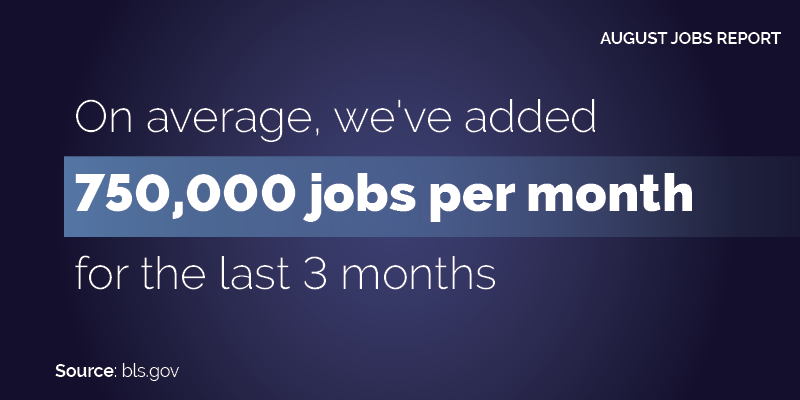
The Bureau of Labor Statistics’ latest jobs report had more good news for America’s workers and paints a picture of a recovering economy with strong job growth, even against the uncertainty of resurgent COVID transmission. Employment rose by 235,000 and the unemployment rate dropped from 5.4% to 5.2%. We’re still making our way towards pre-pandemic employment strength, and while there’s still plenty of work to do, August’s report included some positive indicators.
Here are five numbers from the August jobs report to pay attention to.
+750,000
Over the past three months, we’ve added an average of 750,000 jobs per month. Lower growth in August may reflect ongoing concerns about the coronavirus. As I noted last month, lowering COVID-19 transmission rates is essential to restoring worker and consumer confidence. So if you need a vaccine or a booster (or know someone who does) check out vaccines.gov to find a vaccination site near you.
5x
Our current rate of recovery is five times faster than what we saw during the Great Recession – great news for wages and working conditions. Average wages in restaurants and supermarkets are above $15/hour, and leisure and hospitality workers were earning an average of $18.82/hour, compared to $17.06 a year ago. In short, we’re seeing an economic recovery that’s empowering workers.
76%
The latest report showed that job growth in June and July were even higher than initially reported. To date, we’ve recovered 76% of the jobs we lost in March and April 2020. Since President Biden took office we have recovered 4.5 million jobs, a historic level of job growth.
+0.6%
Last month I said the Black unemployment rate was too high at 8.2%. In August, it rose to 8.8%, nearly twice as high as the white unemployment rate at 4.5%. A full economic recovery is one that benefits all workers, so it’s important to pay attention when specific communities aren’t experiencing the benefits. As I’ve said many times before, more inclusive policies are key to economic recovery.
8.8%
U-6 is a fancy economic term for the total number of unemployed people, plus everyone marginally attached to the labor force, plus everyone employed part time for economic reasons, as a percent of the civilian labor force plus all people marginally attached to the labor force. That’s a mouthful, but it’s essentially our broadest measure of economic hardship, showing us how many people are working less than they want to. In August, that number dropped to 8.8% (down from 14.3% a year ago). That’s a positive sign of economic confidence and opportunity.
Growth in specific industries was a bit of a mixed bag this month. Manufacturing went up. Leisure and hospitality was essentially unchanged. Retail dropped. Transportation and warehousing went up. Health care and nursing went down – particularly troubling because the pandemic is ongoing, the population is aging, and women of color are overrepresented in care economy jobs.
So the big takeaway for August: Recovery continues, but there’s still work to do. As we look to Labor Day and beyond, we want to put policies in place that will build on economic growth and empower all workers.
Janelle Jones is the chief economist of the U.S. Department of Labor.

 U.S. Department of Labor Blog
U.S. Department of Labor Blog